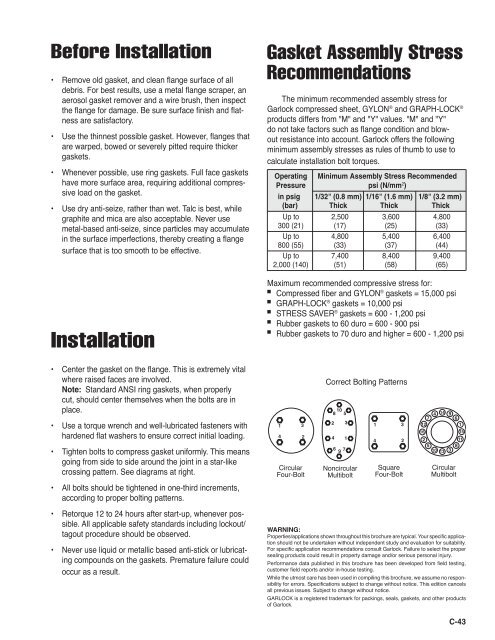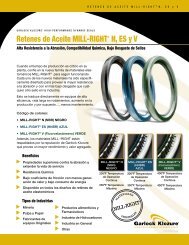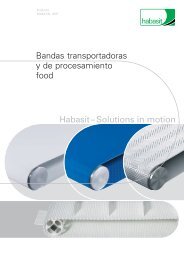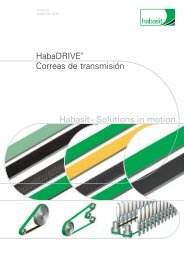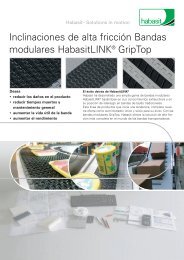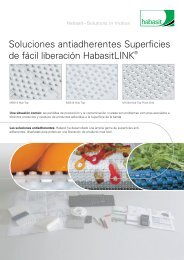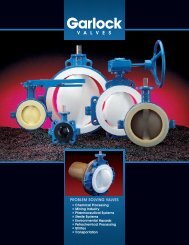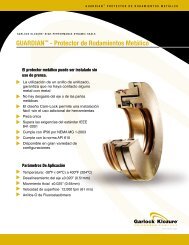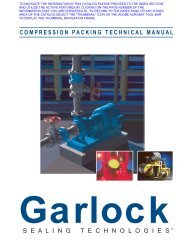Engineered Gasketing Products
Engineered Gasketing Products
Engineered Gasketing Products
- No tags were found...
You also want an ePaper? Increase the reach of your titles
YUMPU automatically turns print PDFs into web optimized ePapers that Google loves.
Before Installation• Remove old gasket, and clean flange surface of alldebris. For best results, use a metal flange scraper, anaerosol gasket remover and a wire brush, then inspectthe flange for damage. Be sure surface finish and flatnessare satisfactory.• Use the thinnest possible gasket. However, flanges thatare warped, bowed or severely pitted require thickergaskets.• Whenever possible, use ring gaskets. Full face gasketshave more surface area, requiring additional compressiveload on the gasket.• Use dry anti-seize, rather than wet. Talc is best, whilegraphite and mica are also acceptable. Never usemetal-based anti-seize, since particles may accumulatein the surface imperfections, thereby creating a flangesurface that is too smooth to be effective.Installation• Center the gasket on the flange. This is extremely vitalwhere raised faces are involved.Note: Standard ANSI ring gaskets, when properlycut, should center themselves when the bolts are inplace.• Use a torque wrench and well-lubricated fasteners withhardened flat washers to ensure correct initial loading.• Tighten bolts to compress gasket uniformly. This meansgoing from side to side around the joint in a star-likecrossing pattern. See diagrams at right.• All bolts should be tightened in one-third increments,according to proper bolting patterns.• Retorque 12 to 24 hours after start-up, whenever possible.All applicable safety standards including lockout/tagout procedure should be observed.• Never use liquid or metallic based anti-stick or lubricatingcompounds on the gaskets. Premature failure couldoccur as a result.Gasket Assembly StressRecommendationsThe minimum recommended assembly stress forGarlock compressed sheet, GYLON ® and GRAPH-LOCK ®products differs from "M" and "Y" values. "M" and "Y"do not take factors such as flange condition and blowoutresistance into account. Garlock offers the followingminimum assembly stresses as rules of thumb to use tocalculate installation bolt torques.Operating Minimum Assembly Stress RecommendedPressure psi (N/mm 2 )in psig 1/32" (0.8 mm) 1/16" (1.6 mm) 1/8" (3.2 mm)(bar) Thick Thick ThickUp to 2,500 3,600 4,800300 (21) (17) (25) (33)Up to 4,800 5,400 6,400800 (55) (33) (37) (44)Up to 7,400 8,400 9,4002,000 (140) (51) (58) (65)Maximum recommended compressive stress for:■Compressed fiber and GYLON ® gaskets = 15,000 psi■GRAPH-LOCK ® gaskets = 10,000 psi■STRESS SAVER ® gaskets = 600 - 1,200 psi■Rubber gaskets to 60 duro = 600 - 900 psi■Rubber gaskets to 70 duro and higher = 600 - 1,200 psi CircularFour-BoltCorrect Bolting Patterns NoncircularMultibolt SquareFour-Bolt CircularMultiboltWARNING:Properties/applications shown throughout this brochure are typical. Your specific applicationshould not be undertaken without independent study and evaluation for suitability.For specific application recommendations consult Garlock. Failure to select the propersealing products could result in property damage and/or serious personal injury.Performance data published in this brochure has been developed from field testing,customer field reports and/or in-house testing.While the utmost care has been used in compiling this brochure, we assume no responsibilityfor errors. Specifications subject to change without notice. This edition cancelsall previous issues. Subject to change without notice.GARLOCK is a registered trademark for packings, seals, gaskets, and other productsof Garlock.C-43


